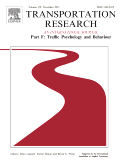
The objective of this research is the development of pedestrian crossing choice models on the basis of road, traffic and human factors. For that purpose, a field survey was carried out, in which a panel of 75 pedestrians were asked to take 8 short walking trips (each one corresponding to a different walking and crossing scenario) in the Athens city centre in Greece, allowing to record their crossing behaviour in different road and traffic conditions. The same individuals were asked to fill in a questionnaire on their travel motivations, their mobility characteristics, their risk perceptions and preferences with respect to walking and road crossing, their opinion on drivers, etc. The walking and crossing scenarios’ data were used to develop mixed sequential logit models of pedestrian behaviour on the basis of road and traffic characteristics. The modelling results showed that pedestrian crossing choices are significantly affected by road type, traffic flow and traffic control. The questionnaire data were used to estimate human factors (components) of pedestrian crossing behaviour by means of principal component analysis. The results showed that three components of pedestrian crossing behaviour emerge, namely a “risk-taking and optimisation” component reflecting the tendency to cross at mid-block in order to save time, etc., a “conservative” component, concerning individuals with increased perceived risk of mid-block crossing, who also appear to be frequent public transport users, and a “pedestrian for pleasure” component, bringing together frequent pedestrians, walking for health or pleasure, etc. The introduction of these components as explanatory variables into the choice models resulted in improvement of the modelling results, indicating that human factors have additional explanatory power over road and traffic factors of pedestrian behaviour. Therefore, the development of integrated choice and latent variables models appears to be an appropriate field for further research.
| ID | pj108 |
| DOI | |
| Tags |








